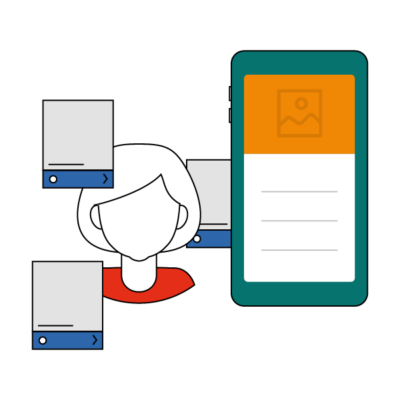There are organizations that simply offer employee training because they have to. Think of training for compliance, hygiene, or privacy guidelines.
If organizations want to take it one step further, they also offer employee training giving them the chance to develop themselves, give confidence and keep them satisfied. Because especially in these times of labor shortages, it is important to retain employees and make sure they are happy. This is also known as employee retention. Several types of research show that personal development is more important than pay and other benefits. So, work to be done!
Benefits of employee training
There are plenty of benefits for training your employees. Let’s zoom in:
- Knowledge retention: This is especially relevant for knowledge that is not used on a daily basis. Through employee training, you remind people of e.g. the guidelines for compliance, privacy, hygiene, or security.
- Onboarding process: For new employees, everything is new. Employee training is the perfect start to welcome new talent within your organization. Read more about online onboarding in this blog.
- Employee performance: with training, people can improve processes, skills, and knowledge. It will boost their confidence, and this will benefit the employee performance.
- Inform people about updates and changes: Organizations are always evolving. How do you ensure that the employees are aware of changes and updates? With employee training, you can create modules to inform people about these changes. This way everyone is informed!
- Uniformity in work processes: Especially in large organizations, it can be wise to standardize processes. Think about the way of documentation in a system or the operation of a machine. With training, you can create uniformity in work processes.
- Employee retention: By offering employees the possibility to keep on developing themselves, they stay qualified for their job and they feel appreciated. This keeps them satisfied and happy with their job

How to start with online employee training?
There is no one-size fits all plan on how to get started with employee training, but there are obviously some things to keep in mind. First, ask yourself: what is the goal?
It seems simple, but what is the most important goal for starting employee training? Defining the goal (or goals) will help you make the right decisions. And related to that: Who is my target audience? Within an organization, there are different types of employees.
Make an inventory of what knowledge is needed for the different positions. Include the stakeholders in the process. If you want to make employee training a great success, you need to involve the right stakeholders. Think of stakeholders who know what is going on in the different departments, have the right knowledge, or can enthuse people to start learning.
Only when you have identified these things can you move on to the next step: creating a plan of action. Once you know who you want to reach and with what content, you can outline which modules and forms of work you specifically need. Whether these are ready-made or need to be tailor-made is up to you based on the learning objective. Following your plan of action, you then choose the right partners, authoring tool and LMS to achieve your goals.
To summarize:
- Define the goal: It always seems so simple, but what is the main goal to start with employee training? By defining the goal(s), you can narrow down all the options and make the right decisions.
- Make a plan: What, where, who? Start by creating a plan. If you know what people have to learn and when you can either choose ready-made training or start creating your own, customized modules.
- Target your audiences: Within your organization, there are different types of employees. Make an inventory of what knowledge and modules are needed for the different job positions.
- Involve stakeholders: Don’t be an island. If you want to make your employee training a huge success, you have to involve the right stakeholders. Think of stakeholders who know what’s going on in the different departments, have the right knowledge, or can enthuse people to start learning,
- Choose software or a platform: Do you want to start using ready-made modules? Do you want to create your own modules? Or are you looking for a combination? Search for the right partners, authoring tool, and LMS to achieve your goals.
Employee retention ideas
Give your training some extra zest! Learning doesn’t automatically have to be boring and serious. There are lots of ways to make your employee training fun, too. Here are some tips:
- Keep it short: Break down your learning content into manageable chunks of content. A hugely long training session is less appealing than short training sessions that employees can easily schedule. Employees are often more willing to make time for several short training sessions than one very long one.
- Activate: Make sure employees have to do something themselves in the training. Activate employees should clickable elements, application exercises, reflection questions, actions they have to take on the shop floor,… Activation also automatically improves retention.
- Give employees choices: Allow employees to choose certain things in their learning. For example, establish a training library so that employees can choose which courses to take based on their interests. For example, let them choose whether they want to take Exercise A or B. Or let employees decide which training course to start with.
- Add gamification: Add game elements to your learning activities. Work with rankings where employees compete against each other, let them earn points each time they complete a section, let them earn medals, reward employees with a certificate or gadget upon completion of training,…
- Be creative: Your learning event does not always have to have the standard structure introduction – information – test. Think out of the box. For example, instead of an instructional video, make a vlog in which an employee covers the most important safety regulations during his working day. Or cast your e-Learning in an escape room format, where people have to earn keys or points to escape. You name it!
Different employee training programs, software or tools
LMS
With a learning management system (LMS) you handle the distribution, reporting and administration of your online training. An LMS is a must-have if you want to organize and keep track of your modules and participants.
Off-the-shelf
There are multiple suppliers for generic of-the-shelf e-Learning. For some subjects this will work, but for more customized content, you probably want to create your own content as well.
Authoring tool
An authoring tool allows you to create and develop your own modules and programs. There are many authoring tools available. With the right authoring tool, you can create and edit e-Learning in-house, in your own brand and with a lot of variety.
Is mobile learning an option for employee training?
Yes! Well, in most cases. Not all employees have access to a (work) phone during working hours. But in general, learning on a mobile device lowers the barrier to entry. This way you offer your employees the freedom to learn when and where they want. On the train, during lunch break, or at home on the couch. By offering mobile learning, you offer your employees flexibility, and this will surely pay off. So in your search for the right tools, keep the responsiveness of all modules in mind.

How to track employee training progress?
We were talking earlier about an LMS. The progress of your employees can be tracked with an LMS (Learning Management System) An LMS gives you all insights of your modules, programs and participants. This system will help to digitize and automate workflows. With an LMS you can:
- Create the desired learning flows
- Easily manage courses and participants
- Track progress and results
- Generate report
Develop employee training with FLOWSPARKS
Do you want to know the best ways to retain your employees? Schedule a demo with FLOWSPARKS. We’ll be happy to show you the possibilities.
Request a demo
FAQ Employee Retention
What is employee retention?
Employee retention is the practice of implementing strategies and policies to keep talent within a company for an extended period of time. It covers a wide range of aspects of the employee experience, from attracting qualified candidates to nurturing their development and ensuring job satisfaction. Employee retention, in essence, means using a proactive and complete approach to creating a committed and engaged workforce, resulting in a more resilient, productive, and successful organisation.
Why employee retention is important
Employee retention is critical for organisations seeking to be (and remain) successful in today’s competitive landscape. Employee retention is critical for modern organisations because it provides numerous benefits that influence their development and success. It saves money by avoiding expenses such as recruitment, training, and decreased productivity during transitions. Long-term employees also improve productivity because their prior experience with roles reduces onboarding time for new hires.
They also help maintain critical knowledge about the organization, which allows for better decision-making. Retention promotes a positive organisational culture by encouraging new employees to share the company’s values. Employees who are satisfied and committed are more engaged, which leads to increased job satisfaction and collaborative success.
Employee retention, in the end, is an essential strategy that drives success by lowering costs, increasing productivity, preserving knowledge, promoting a strong culture, and increasing employee engagement.


